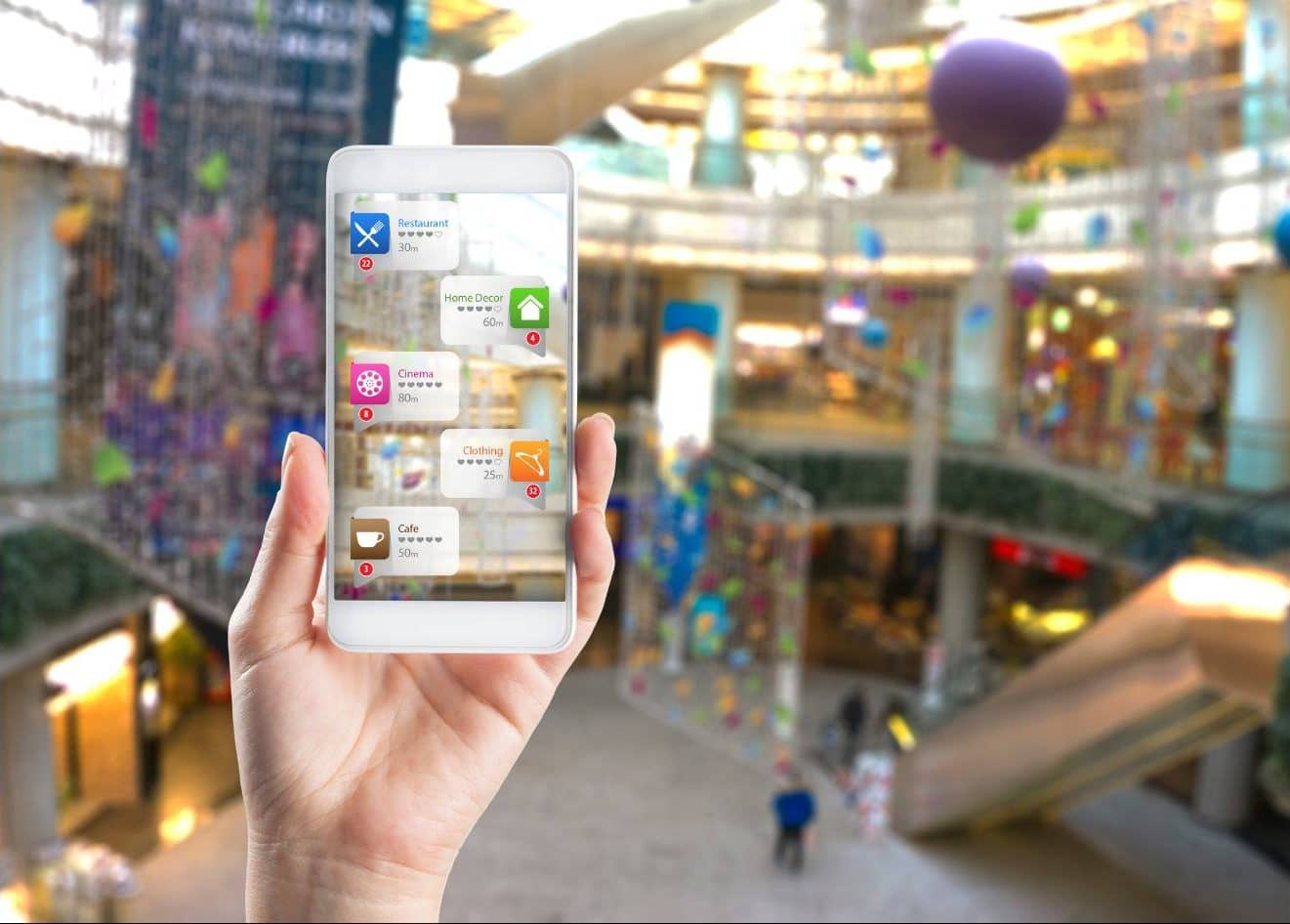Discover why Augmented Reality is the future of advertising.
Traditional marketing channels have long been the mainstay of businesses trying to reach their target audiences. However, the rapid evolution of technology and changes in consumer behaviour have rendered these traditional channels less effective in today’s digital world. As a result, businesses are increasingly embracing augmented reality (AR) as an innovative marketing tool. In this article, we will explore why traditional marketing channels are declining and how AR is emerging as a theme that can reshape the marketing landscape. Looking into AR’s benefits, Comparing traditional methods to AR, and AR’s role in the future for marketing. Additionally, exploring the benefits of location-based AR, a growing trend in AR marketing, enables businesses to target audiences at the point of purchase and consumption.
Understanding the Decline of Traditional Marketing Channels
Consumer behaviour has undergone a seismic shift in recent years, primarily driven by the widespread adoption of digital devices and the internet. People are no longer passive recipients of marketing messages; they actively seek out information, do research, and make informed decisions. This shift has diminished the effectiveness of traditional marketing channels, such as TV ads, radio spots, and print advertisements. Consumers now demand personalised, interactive, and immersive experiences that traditional channels struggle to deliver.
Digital transformation has revolutionised the way businesses operate and communicate with their audiences. The continued development of social media, search engine optimisation, and content marketing has created new opportunities for companies to engage with their customers. Digital channels allow for targeted advertising, real-time analytics, and personalised messaging, enabling businesses to reach the right people at the right time with the right message. Traditional marketing channels simply cannot compete with the speed, precision, and cost-effectiveness of digital marketing.
Moreover, traditional marketing channels often have limited reach and accessibility compared to digital platforms. TV and radio ads are limited by time slots and geographic coverage, while print ads are constrained by circulation. These limitations make it challenging for businesses to effectively target specific demographics and measure the impact of their marketing efforts. In contrast, digital marketing channels offer a wide reach, global accessibility, and sophisticated tracking capabilities.
One of the key advantages of digital marketing is its ability to provide real-time feedback and data. With traditional marketing channels, businesses have to rely on surveys, focus groups, and market research to gather insights about their target audience. This process can be time-consuming and may not always provide accurate or up-to-date information. In contrast, digital marketing allows businesses to track user location, behaviour, engagement, and conversion rates in real-time. This data can be used to optimise marketing campaigns, refine messaging, and make data-driven decisions.
Furthermore, digital marketing offers unparalleled opportunities for personalisation and customisation. With traditional marketing channels, businesses have limited control over the content and timing of their messages once published. However, with digital marketing, businesses can tailor their messaging to specific segments of their target audience at specific times and locations, ensuring that each individual receives a personalised experience. This level of customisation not only enhances the effectiveness of marketing efforts and allows for live amendment of the campaign, but also helps build stronger relationships with customers.
The Rise of Augmented Reality in Marketing
As traditional marketing channels struggle to keep up with evolving consumer preferences, augmented reality (AR) is emerging as a powerful tool to captivate and engage audiences. Especially considering the increasing focus on location-based AR, which enables targeting audiences at the point of purchase and consumption. AR overlays virtual elements onto the real world. This technology has gained significant traction in various industries, including gaming, entertainment, education, and now, marketing. One needs to explore AR to understand the current shift from traditional marketing to AR.
Defining Augmented Reality
Augmented reality (AR) enhances the real world by adding virtual elements. With the development of smart mobile devices, users can experience a blended reality where digital content, such as images, videos, or animations, is overlaid onto their physical environment. This seamless integration of virtual and real-world elements creates
interactive and immersive experiences that can be highly engaging and memorable, that leave a lasting impact on consumers.

The Benefits of AR in Marketing
AR offers numerous benefits for businesses looking to enhance their marketing efforts, driving the shift from traditional marketing to AR. Firstly, these technologies provide an unparalleled level of engagement and interactivity. By integrating AR into marketing campaigns, companies can capture users’ attention and involve them in immersive experiences. This increased engagement translates into higher brand awareness, improved customer loyalty, and ultimately, increased sales.
Secondly, AR enables businesses to showcase their products and services in new and exciting ways. Instead of relying on traditional product photos or descriptions, companies can use AR to allow customers to partake in virtual hunts, virtually try products, explore virtual showrooms, or visualise how products would fit into their real-world environment. These experiential marketing strategies enhance the customer’s understanding, trust, and confidence in the brand, leading to greater conversions.
The Benefits of Location-based AR in Marketing
Location-based AR offers a powerful tool to engage audiences at the point of purchase or consumption, enhancing marketing strategies and customer experiences. This tool offers several benefits.
Firstly, location-based AR enables personalised interactions. Customers receive tailored content based on their location, making their shopping experience more engaging and relevant.
Secondly, by delivering targeted promotions or product information precisely when customers are considering a purchase, AR can boost sales conversion rates. Customers are more likely to buy when presented with compelling, context-aware offers.
Thirdly, AR transforms the shopping experience into an interactive journey. Customers can visualise products in their intended environment or receive guidance through complex purchasing decisions, ultimately improving satisfaction.
Additionally, AR can suggest add-ons or upgrades based on customer preferences and behaviour. For example, an AR menu might recommend a specific wine pairing or dessert based on a customer’s meal selection.
In summary, location-based AR at points of purchase and consumption empowers businesses to connect with customers in meaningful ways. By delivering targeted, personalised content where and when it matters most, AR enhances engagement, drives sales, and creates memorable customer experiences. This technology represents a transformative approach to marketing and customer interaction in physical spaces.
How AR is Changing the Marketing Landscape
AR is revolutionising the marketing landscape by providing innovative solutions to age-old challenges. AR-powered applications, for example, allow businesses to engage with their customers in real-time, and can gather valuable first-person behavioural data from their consumers engaging with the applications. These immersive experiences save time, money, and effort for businesses.
Furthermore, AR has the ability to create shareable content that can amplify a brand’s reach. Users often share their AR experiences on social media, creating user-generated content that drives organic brand exposure and increases brand virality. This word-of-mouth marketing can exponentially expand a company’s reach and attract new customers.
Additionally, being able to present relevant content in the context of the audience’s location offers significant benefits for businesses in converting sales or upselling.
Comparing Traditional Marketing Channels and AR
When comparing traditional marketing channels to AR, it becomes clear that the latter offers several advantages. Firstly, engagement and interaction levels are significantly higher with AR experiences compared to traditional marketing channels. AR offers a level of interactivity and immersion that cannot be replicated by print ads or TV commercials. Users can actively explore, manipulate, and interact with virtual elements, creating a deeper connection with the brand and its offerings. This heightened engagement enhances the overall brand experience and fosters positive brand associations.
Additionally, the accessibility and reach of AR surpass that of traditional marketing channels. Traditional channels, usually have limited geographic coverage or specific target demographics. In contrast, AR experiences can be accessed globally through mobile devices. This accessibility opens up new markets and allows businesses to connect with a wider range of customers. The aforementioned benefits are drivers for the shift from traditional marketing to AR.
Future of Marketing: Embracing AR
As the shift from traditional marketing to AR continues to gain momentum in the marketing world, businesses must prepare for the revolution they bring. Embracing AR is not only about adopting the latest technology trends but also about understanding and capitalising on the unique opportunities these technologies present.
The Role of AR in Future Marketing Strategies
In the future, AR will likely become an integral component of marketing strategies across industries. Companies will use AR to create personalised, immersive, and interactive experiences that resonate with their target audiences. From virtual hunts to interactive storytelling, these technologies will enable businesses to deliver highly engaging and memorable experiences that traditional channels simply cannot replicate.
Potential Challenges and Solutions in AR Marketing
While the future of marketing with AR is promising, there are some challenges that businesses may face. Firstly, the cost of developing complex AR experiences can be a barrier for smaller companies.
Secondly, ensuring a seamless user experience is crucial when implementing AR solutions. Therefore, businesses must prioritize user testing and quality assurance before launching AR campaigns to guarantee a flawless experience for their customers.
As consumer preferences continue to evolve and traditional marketing channels lose their effectiveness, businesses must embrace new tools and technologies to stay relevant. Augmented reality offers unique opportunities to engage consumers, create immersive experiences, and drive brand recognition. By taking action now, businesses can navigate the evolving marketing landscape and secure a competitive advantage in the digital age.

